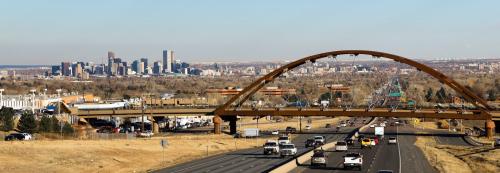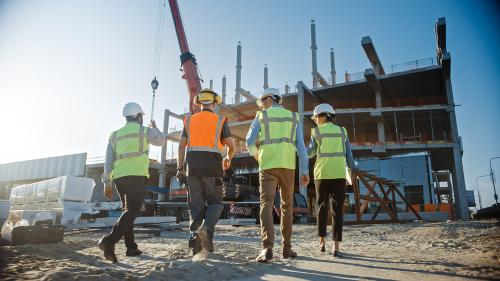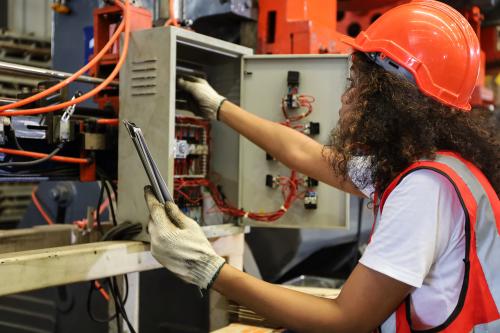It has been over a year since the Infrastructure Investment and Jobs Act passed, unleashing an unprecedented $864 billion in federal funding to improve the country’s transportation, water, energy, and broadband systems. This comes on top of hundreds of billions of dollars for related climate and industrial investments in the Inflation Reduction Act and CHIPS and Science Act. And with this funding has come the enormous potential to support up to 15 million new jobs over the next decade, according to the most ambitious estimates. Many state and local entities eligible to receive this funding—think transportation departments, water utilities, and more—are scrambling to secure new pots of money and get workers ready for all the projects to come.
The problem with this gold rush mentality is that federal, state, and local leaders often overlook a fundamental problem facing the country: They cannot even hold onto current infrastructure workers, let alone find more of them to carry out this pressing work.
The U.S. infrastructure workforce is rapidly losing talent. As recent Brookings research shows, nearly 17 million infrastructure workers are projected to permanently leave their jobs over the next decade due to a wave of retirements, job transfers, and other labor market shifts. Infrastructure workers are not just construction workers—they are plumbers, electricians, civil engineering technicians, or dozens of other occupations, primarily involved in the skilled trades. And they are responsible for operating and maintaining our roads, rails, pipes, power plants, and other facilities over many decades. Filling these shoes is not simply about patching a pothole or building a bridge—it represents a generational challenge affecting many industries nationally.
Since some of these 17 million workers may only be switching positions and not leaving the sector entirely, this figure does not necessarily capture the full range of the country’s infrastructure hiring needs. But it does signal a growing retention gap. For instance, bus drivers, dredge operators, and helpers to electricians are among the infrastructure occupations with the most significant “separations”—an average annual measure estimated by the Bureau of Labor Statistics (BLS) to capture how many workers are projected to leave their jobs. Each of these occupations is projected to see 12% (or more) of their workers leave annually over the next decade, which exceeds the separations rate for all occupations nationally (11.5%). Moreover, these separations greatly exceed the total growth rate (i.e., new jobs) estimated for all occupations nationally (5.3%) over the next decade.
Yet filling these new infrastructure jobs also represents a generational opportunity. Infrastructure jobs pay 30% more to lower-income workers and those just starting their careers relative to all jobs nationally, while also posing lower formal educational barriers to entry. But too many workers—especially younger workers, women, and people of color—continue to be sidelined from these careers. The infrastructure workforce is aging, male, and white; only 11% are 24 years old or younger, 18.5% are women, and under a third are people of color. Many prospective job seekers not only lack awareness these positions exist, but they also lack flexible and accessible pathways to fill them, including struggles to gain needed on-the-job training and limited supportive services (e.g., child care, transportation).
Difficulties in hiring, training, and retaining a younger, more diverse workforce limit economic opportunity, slow down projects, and pose the very real possibility of mission failure for infrastructure employers, including the owners and operators of these systems. Without enough skilled electricians, for example, installing electric vehicle charging stations, upgrading buildings, and deploying clean technologies will be extremely hard and reduce the reach of new federal climate efforts. Infrastructure workers and employers stand to lose—as do all Americans.
These difficulties are also likely to get worse given the country’s declining—and diversifying—labor force participation. The BLS estimates that the U.S. labor force participation rate—the percentage of the population that is working or actively looking for work—has gone up since the pandemic, to 62.6% last month. However, this rate is still lower than the pre-pandemic level (63.3%), and further declines are projected over the next decade (down to 60.1%)—continuing a longer-term trend as more baby boomers exit the labor force. More recent shifts that arose during the pandemic, such as staff burnout, may begin to play a bigger role in future estimates too.
Amid these broader declines, an even more significant change may soon impact the infrastructure workforce: The overall labor force will grow from 161 million workers to 169 million (an additional 4.8%) over the next decade, largely driven by women and people of color—the groups traditionally overlooked and marginalized across the infrastructure sector. From 2021 to 2031, the number of women in the U.S. labor force will increase by 6.1%, while the number of men will only increase 3.5%. At the same time, the number of Black and Latino or Hispanic workers will increase 8.2% and 23.6%, respectively, while the number of white workers will only increase 1.6%. The BLS does not separately report other racial groups—including Asian American and Native American workers—but groups in the “all other” category will grow the fastest (24.1%).
In other words, bridging the infrastructure sector’s talent gaps in the short term needs to coincide with building a stronger long-term talent pipeline, which crucially depends on reaching and supporting more diverse workers. Reversing the tide of departures in this sector cannot happen overnight, especially as more workers age out of their positions. But the current influx of federal funding gives state and local leaders, including infrastructure employers as direct recipients, the opportunity to test more forward-thinking approaches to workforce development rather than doing business as usual.
That means conducting more extensive community outreach to reach new and different workers, including additional demonstration projects. That means collaborating with workforce development boards, educational institutions, community-based organizations, and other partners to define hiring and training priorities, expand work-based learning options, and provide more supportive services. That means changing how infrastructure projects are done, including new local hiring standards, procurement strategies, and contracting practices to reach women- and minority-owned businesses. That means valuing and retaining current infrastructure workers, including steps toward continued career growth. And that means collecting better data and creating new benchmarks for success over time, focused on equity and inclusion.
The list goes on, but the key is for infrastructure and workforce leaders to both recognize the urgency of this challenge and the need to start experimenting with a different approach. Time is fleeting, and the federal money is already flowing. The path of least resistance—relying on the same types of workers, hiring and training strategies, and more—will not only fail to curb the outflow of talent across the infrastructure sector, but also fail to truly expand the talent pool and maximize the current window of federal funding.
Thanks to Megumi Tamura for excellent research assistance on this post.










Commentary
The incredible shrinking infrastructure workforce — and what to do about it
May 11, 2023